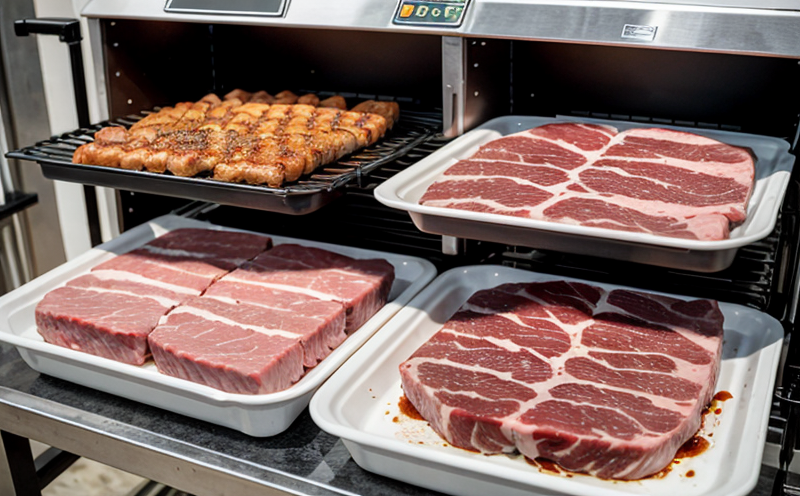ISO 16654 E. coli O157:H7 Testing in Beef
The presence of E. coli O157:H7 is a critical concern for the food industry, particularly within beef production and processing. This strain of bacteria can lead to severe health issues including bloody diarrhea, kidney failure, and hemolytic uremic syndrome (HUS). The ISO 16654 standard provides robust guidelines for detecting E. coli O157:H7 in food products, offering a standardized approach that ensures accurate identification and reporting.
The first step in this testing process involves proper specimen preparation. Beef samples must be collected from various parts of the carcass to ensure representative sampling. These samples are then homogenized using sterile techniques to create an evenly distributed sample for analysis. Once prepared, the samples undergo microbiological culturing under controlled conditions to promote bacterial growth.
Following incubation, the presence of E. coli O157:H7 is detected through biochemical testing and serotyping methods. The standard protocol involves using selective media that favors the growth of this specific pathogen over other microorganisms. Positive cultures are further identified by their characteristic colony morphology on these selective plates.
The ISO 16654 method also incorporates advanced molecular techniques such as polymerase chain reaction (PCR) and mass spectrometry for rapid and accurate detection. These technologies provide precise identification of E. coli O157:H7 even in low concentrations, ensuring early intervention if contamination is detected.
The use of this standard not only enhances food safety but also aligns with regulatory requirements set by various governmental bodies worldwide, such as the Food and Drug Administration (FDA) and the European Commission. Compliance with ISO 16654 ensures that meat products are safe for consumption, thereby protecting public health.
Quality managers and compliance officers rely on this testing method to maintain high standards of food safety within their operations. R&D engineers benefit from accurate data generated by these tests in developing new processing methods aimed at eliminating contamination risks. Procurement teams also play a crucial role by ensuring suppliers adhere to strict quality control measures, including ISO 16654 compliant testing.
A table summarizing the key steps and results of the ISO 16654 method is provided below:
| Step | Description |
|---|---|
| Sample Collection | Carcass sampling from various parts for representative analysis. |
| Sterile Homogenization | Even distribution of sample through sterile techniques. |
| Microbiological Culturing | Growth conditions favoring E. coli O157:H7. |
| Positive Culture Identification | Detection based on colony morphology and biochemical testing. |
| PCR/Mass Spectrometry | Rapid, accurate identification of the pathogen using advanced molecular techniques. |
The ISO 16654 method is widely recognized for its reliability and accuracy in detecting E. coli O157:H7 in beef products. By adhering to this standard, laboratories ensure consistent results that meet both regulatory and consumer expectations.
At Eurolab, we pride ourselves on providing unparalleled expertise in food safety testing. Our team of highly skilled microbiologists and chemists ensures that each test conducted meets the highest standards of accuracy and reliability. With a focus on cutting-edge technology and rigorous quality control procedures, we offer services tailored specifically to meet your unique needs.
Our state-of-the-art laboratories are equipped with the latest instrumentation and software necessary for precise detection of E. coli O157:H7. This includes advanced PCR machines capable of rapid amplification of target DNA sequences, as well as high-resolution mass spectrometers used in confirmatory testing.
Client satisfaction is our top priority at Eurolab. We offer flexible appointment scheduling to accommodate busy schedules and provide detailed reports within industry-standard turnaround times. Our commitment to excellence extends beyond just providing results; we also offer expert interpretation of findings, helping you understand the implications for your business operations.
In addition to ISO 16654 compliance, Eurolab adheres strictly to other relevant international standards such as AOAC International and FDA guidelines when conducting meat & poultry analyses. This ensures consistency across all tests performed in our laboratory.
Environmental and Sustainability Contributions
By ensuring that beef products are free from harmful pathogens like E. coli O157:H7, we contribute positively to environmental sustainability efforts. Cleaner food chains reduce the need for extensive medical treatments due to foodborne illnesses, which in turn lessens healthcare burdens on communities and governments.
Our adherence to stringent quality control measures helps minimize waste throughout the supply chain by preventing contaminated products from reaching consumers. This not only saves resources but also reduces negative impacts associated with disposal of substandard goods.
The use of advanced molecular techniques like PCR allows for more efficient detection processes, reducing resource consumption compared to older methods that may require larger sample sizes or longer processing times. Additionally, our commitment to continuous improvement means we regularly update our protocols based on latest scientific research and technological advancements.
Use Cases and Application Examples
Supply Chain Monitoring: Regular testing at every stage of the supply chain ensures that all beef products entering the market are safe for consumption.
Supplier Audits: Conducting ISO 16654 compliant tests on raw materials purchased from suppliers helps maintain consistent product quality and safety standards across multiple locations.
New Product Development: Incorporating this testing into research projects allows developers to identify potential contamination risks early in the development process, leading to safer products.
Post-Market Surveillance: Continuous monitoring of market offerings helps monitor trends over time and respond promptly to any emerging issues related to E. coli O157:H7.
| Use Case | Description |
|---|---|
| Supply Chain Monitoring | Regular testing at every stage ensures all products are safe for consumption. |
| Supplier Audits | Testing raw materials purchased from suppliers maintains consistent product quality and safety standards. |
| New Product Development | Incorporating this into research projects helps identify potential contamination risks early in the development process. |
| Post-Market Surveillance | Continuous monitoring of market offerings helps monitor trends over time and respond promptly to any emerging issues. |





